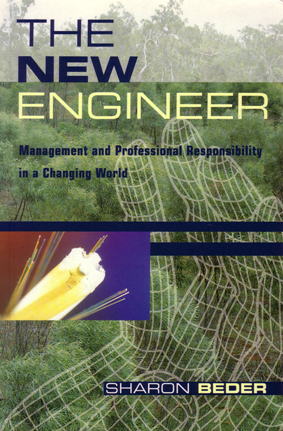
The New Engineer
Management and Professional Responsibility in a Changing World
by Sharon Beder
Published by:
MACMILLAN, Australia, Hb ISBN: 0-7329-4676-X
Pb ISBN 0-7329-4675-1
Publication date: 1998
342 pages; 234 x 156 mm
The image and status of the engineering profession is declining as the public identifies engineers with controversial and environmentally damaging technologies. Engineers are too often characterised as being male, socially inept, politically naive and aligned with selfserving developers. They are finding themselves at the centre of controversies they don't fully understand. Increasingly engineers are subjected to law suits because the public, which has an unrealistic perception of the nature of engineering, blames them when things go wrong.
Engineering appears to be at a turning point. It is evolving from an occupation that provides employers and clients with competent technical advice to a profession that serves the community in a socially and environmentally responsible manner. Increasingly engineers themselves and their professional societies aspire to be broadbased professionals. Employers are also requiring more from their engineering employees than technical proficiency.
Engineering in the modern world involves many social skills. There is also an increasing need for engineers to choose technological solutions that are appropriate to their social context and to give consideration to the longterm impacts of their work, if only because the work of engineers can have wideranging effects. Today's technologies can impact on the whole globe and they can impact on future generations. Never before has there been such a moral imperative to consider what may have been thought of as unintended consequences in the past.
This book sets out to provide a resource to help engineering students understand the social dimensions and context of engineering work as well as the social role and responsibilities of the new engineer. Part One canvasses the issues and develops the debates central to a discussion of engineering in contemporary society. Part Two shows how those debates are put into action with a detailed case study highlighting most of the key concerns for the new engineer, while Part Three develops the general discussion about engineers and the environment, engineering ethics, and engineers at risk. It also seeks to stimulate discussion within the profession about the qualities of the new engineer and to provide insights to nonengineers who have an interest in the shaping and implementation of technology in modern society.
Introduction
Part I Engineering - past and present
- The traditional engineer
Science and Status
Choosing Engineering as a Career - The engineering profession
Career Structure
Professionalism
Professional vs Business Values
Appendix - Engineering design and philosophy
Preindustrial Design
Modern Design Methods
Engineering as Experimentation - Development of technology
Technological Choice
Technology as a Social Activity
Technological Paradigms and Trajectories - Cleaning up the cities
The Battle for Sewers
WaterCarriage vs Dry Conservancy
Government and Social Control - From sewage farms to sedimentation tanks
Sewage Experiments
Trends in Sewerage Treatment
A Sewerage Engineering Paradigm?
Prospects for Change - Controversy - Sydney`s beaches in crisis
Ocean Outfall Predictions
Bioaccumulation Studies of Sydney Fish
Manipulating the Media - Technology and regulation
The Basis for Environmental Standards
Influencing Technological' Change
The Cost to Industry - Technology and the environment
Technology as a Cause of Environmental Problems
Appropriate Technology
Clean Technology
Appendices - The role of experts
The Basis of Expert Authority
Defining Decisions as Technical
Public Participation - Engineering ethics
A Social Contract
Environmental Impact Assessment
Support for Ethical Engineers
Appendices - Engineers at risk?
Risk Assessment and Communication
Incinerator Case Study
Conclusions - The new engineer
Part II Sewerage case study
Part III The new engineer and social responsibility